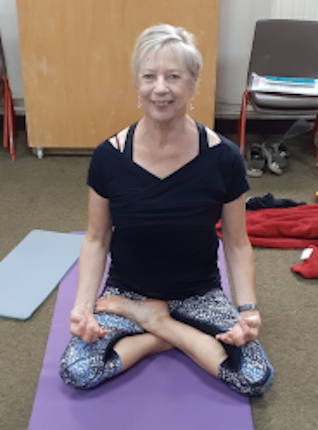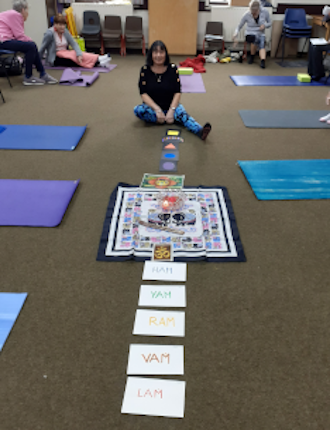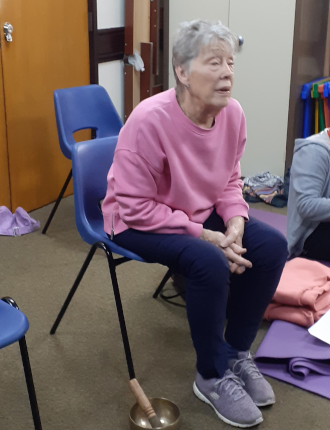CYTA’s Autumn Training Day at Wilmslow Methodist Church Hall.

On Saturday 16th October 2021 we all gathered at Wilmslow Methodist Church for the CYTA half day training event. The day began with a brief introduction form our chair Christine Royle.
Our first session was hosted by Anne Goldstraw and entitled “Postures with Attitude” where Anne described the postures and explained how each relates to our attitude and how the pose affects us.

We began in the Sphinx pose with some gentle head rolls to stretch out our necks. Anne told us that the reason we can hear our neck click is because it is so close to our ears (which we were glad to hear as some of us felt that!).
Following the Sphinx we moved on to the Cobra pose which we held while breathing correctly feeling the lift in our abdomen and chest.
Next was the cat pose using the 6:3 breath ratio along with observing the pause after the inhale and the still point after the exhale.
Our next pose was a kneeling Warrior One which stretched our hips and pelvis along with feeling the lift through the chest. We held out arms either in cactus or straight up by our ears with the option of clasping hands together and pointing our forefingers upwards.

We then moved into a standing Warrior One with the feet staggered. This helped with balance and enabled us to perform a deeper back bend.
The Child’s pose was next with arms stretched forwards or relaxed by the lower legs.
Before the practice ended, Anne showed us a threading pose in prone which was recommended for stiff shoulders.
This was a very invigorating and enjoyable class.
Thank-you Anne for your excellent teaching.
Following a short break Christine Royle took the second session on the Tatwas.

Christine set up some visual aids and explained what the tatwas were – fundamental principle or truth. To begin with we concentrated on the base chakra, sitting in cobbler pose breathing in as we stretched up and breathing out as we relaxed forwards then bounced our knees. This was followed by lying down and breathing in a square around the pelvis. We then moved on to lying cobbler where we gently bounced our thighs. The next part of the practice involved standing up with our feet slightly apart imagining a square around our feet, we gently moved around the square alternating the weight around our feet. We returned to the mat to perform some pelvic floor contractions.
These poses and the shape of a square stimulated our earth centre and awakened our kundalini energy.
We looked at the chakras and the elements in each one, chanting the bija mantras relating to each one before meditating upon each chakras properties from muladhara chakra at our base up to vissudhi chakra at the throat. At the earth element (base chakra) Christine stimulated our sense of smell by spraying rose water around the room:

At the water element we visualised water, our hands in a fountain, drinking.
At the fire element we visualised a fire, flames and the heat they produced.
At the air element we concentrated on breathing first with others in the room, then with animals and trees.
We then brought our attention to the throat chakra and observed the silence there.
Lastly we brought our attention to the third eye to see and feel the silence there.
The session ended in a sitting position with hands in chin mudra and chanting thee Oms.
A wonderful practice which everyone enjoyed. Thank-you Christine.
After a second short break Diana Davidson took the floor with a breathing relaxation/meditation.
Diana explained she first experienced this meditation/relaxation at the Buddhist centre, Manchester in 1998. As both a therapist and yoga teacher, Diana has found this practise to be very beneficial to patients and students alike; helping to reduce stress and create a sense of positive energy and well-being. The concept of this practice is mindfulness and is taken from the basic Dhyana Sutras in the Buddhist tradition. We moved into comfortable positions and Diana began.

We used our breath to realise the oneness between body and mind as we silently repeated a phrase on an inhalation and another phrase on the exhalation. This was repeated slowly ten times before new phrases were introduced. Two of the phrases were “Calming my body I breathe in, Caring for my body I breath out” and “Dwelling in the present moment, I know it is a wonderful moment”. For more details on this meditation please refer to the book The Blooming of a Lotus by Thich Nhat Hanh, published by Beacon Press, Boston.
Diana gave us plenty of time inbetween each repetition, this practice helped us to feel completely in tune with ourselves.
Diana ended the practice with these profound words “Rise in peace, walk in tranquillity, stay in harmony.”
This alternative style of meditation was new to some of us and very well received. One teacher called it “Bliss”. Thank-you Diana for a lovely meditation.
Thank you to everyone who attended and organised the event especially to Sue Hargreaves and Judith Lynch who sadly could not attend on the day.
Additional resources from the event.
The three teachers from this event have kindly donated their lesson plans. Please find the lesson plans reproduced below:
Postures with Attitude by Anne Goldstraw
I thought of particular animals and how they stretch. I thought of their strengths and how they move and quickly decided to use the Cobra and The Cat. Then I wanted a standing pose and chose Warrior One, finally relaxing in the Pose of the Child.
I had 30 minutes for the session so divided each asana to around 8 minutes. I timed myself for the description of each pose and the actual practicing of it.
I read out these notes.
Attitude meaning posture of the body, behaviour and body language.
Giving your poses a bit more flexibility and interest can enhance rather than dilute the practice. Poses should be moving meditation and because we all have different bodies able and disabled we should be aiming for the essence of the pose and not the perfect pose. Visualising the animals as we did each pose gave it all a bit of interest and meaning.
We practised BHUJANGASANA The Cobra and I talked about how the Cobra has a huge amount of strength. How the open chest shows freedom and space. We started with the sphinx, followed by plank dropping into full cobra and then did full cobra by levering yourself from the mat. At the end I said…… I AM STRONG, I AM ALERT. I CAN MOVE ON
MARJARIASANA the Cat. The cat oozes sensuality, has endless patience and is very independent. I talked about being kind to ourselves, nurturing and pampering ourselves. At the very end I said REMEMBERING LIKE THE CAT, YOGA IS PATIENCE.
VIRABHADRASANA – WARRIOR ONE….. We all practised it from kneeling which I think is easier with much padding under the kneeling knee. Some of the class then did it standing all with modifications with their arms-hands. Talked about needing physical strength and how the pose affirms the this attitude of strength, stamina purpose and bravery. I AM A WARRIOR I AM READY FOR LIFE.
BALASANA THE POSE OF THE CHILD. Again done with variations. WE HAVE NO NEED TO LOOK OUTSIDE AND ALL THAT WE NEED IS ALREADY HERE. I ACCEPT WHO I AM.
The TATWAS by Christine Royle
- I read my Introduction on the Tatwas from my lesson notes February 1985.
- I showed the Visual aid symbols of each Tatwa and gave their meaning.
The symbols represent the energies of each Element, and are reinforced by reciting the Bija sounds.
- You can work on one Tatwa per week. Students can make their own card symbols.
- I gave the lesson on the first Tatwa. Earth Element.
- Sitting in the Cobbler pose
- Contracting the Moola Bandha.
- Breathing in a square
- Read the Earth Invocation and chanted the Bija sound Lam.
- Said the Affirmation (I give myself Space to Grow) ask all to repeat three times.
- Finished lesson all canting OM three times.( After OM there is Silence).
Relaxation and Meditation by Diana Davidson
Script taken from various sections of The Blooming of the Lotus Thich Nhat Hanh Obtainable on line
I chose this particular meditation because I have used it many times as both a therapist and a yoga teacher and found it effective in achieving a feeling of well being and calm but it is easy for students of all abilities to follow..
This session was planned to last for 30 minutes, due to the design of the book’s contents it can be shortened or lengthened according to how much time you have in the session. You can also choose subject matter to fit your chosen theme for the lesson. In fact I changed my original plan so that I could pick up the themes of Anne’s session e.g. strength and freedom
I would use this relaxation towards the end of term when students have become used to the idea of being able to control their breathing. I would have also introduced the use of mindfulness in quietening the mind.
5 minutes It is important to ensue that students are warm, correctly positioned and comfortable for relaxation, the use of blocks, cushions etc can be used or a chair if they have difficulty in lying on the floor. Darken the room. Take time to let them settle. Make sure that there are no outside distractions. I don’t use music as this can trigger thoughts that get in the way of the themed relaxation.
2 minutes Introduce theme stressing the need for concentration on the breath and each instruction e.g. breathing in I see myself as a mountain- breathing out I feel strong x 5. The number of breaths can be increased as students become more adept and time allows
15-20 minutes continue with chosen exercise verses
5 minutes prepare students to become fully aware again encourage them to stretch, sit up, take 3 breaths as they raise arms over head
I like to round off my sessions with a salutation/verse/omm.
